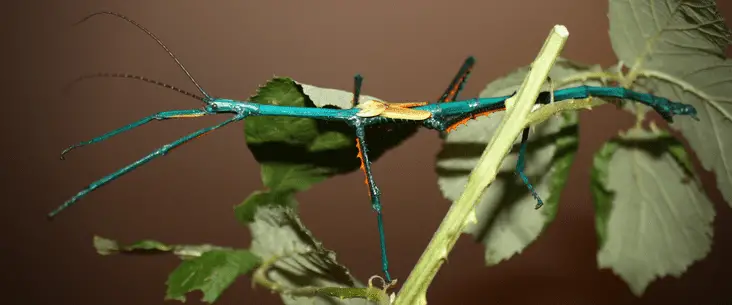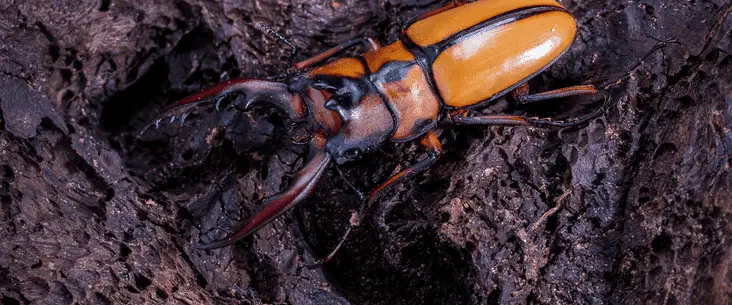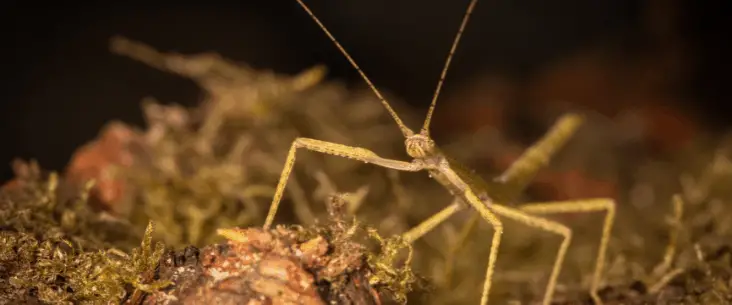Are you looking for a colourful, interesting and inexpensive pet without high requirements? Look no further and take some African sun beetles (Pachnoda marginata). They are probably the most popular fruit beetle in the pet industry, but that doesn’t make them less interesting. These fascinating beetles are easy to keep and widely available. Besides that, you can easily combine them with other bug species like other flower beetles, snails and millipedes. In this article, we discuss how you can provide the best care for these beautiful little beetles.
You can easily house sun beetles (Pachnoda marginata) in a terrarium, faunarium or plastic container. You should provide enough ventilation, comfortable warm temperature (between 20-28°C/68-82°F), a good 4″ (10cm) layer of a quality substrate, and provide different nutritious foods. Your beetle colony will quickly start breeding and thrive.
That sounds easy, right? Well, keeping sun beetles is rather easy, but it is important to provide good care. How you do that? We will discuss 5 main topics: Housing, environment, climate, feeding and breeding. This will provide a complete hand-out to give these colourful friends proper care. But first, let’s talk more about sun beetles.
We partner with companies that offer products that we think are great for you to use, and that can help you achieve your goals. If you purchase through our partner links, we get paid for the referral at no additional cost to you! Please read our disclaimer for more info.
About Sun Beetles (Pachnoda marginata)
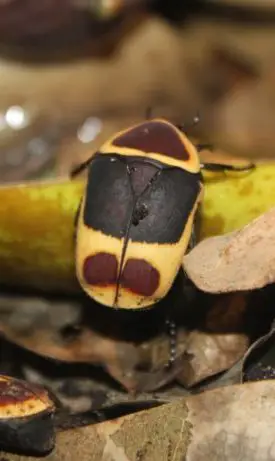
Appearance
The sun beetle can be recognized by its distinctive yellow front wings with brownish-black spots. The rest of its body is shiny black. The wings are black-transparent. It is a medium-sized beetle that has an average size of around 1″ (2.5cm). It has a typical beetle body plan but lacks any oversized appendages like seen with many other beetles. Generally, most beetles are sexually dimorphic — meaning that there is a visual difference between males and females. However, sun beetles of both sexes look pretty much the same.
The larvae — also called grubs — are completely white when they hatch. They slowly turn more white-yellow and a darker brown head. Grubs can be rather large, with sizes around 1.5″ (4cm) long. Fully grown grubs (that are almost ready to pupate) are evenly thick as your pinky finger.
There are 9 different recognized subspecies of sun beetles, and all are readily available from breeders. All differentiate in colour patterns on the front wings, but the rest of the body has the same shape and colours.
A quick tip: Although male and female sun beetles look pretty much the same, you can sex them easily. The difference between them is that male sun beetles have a thin line running centrally down the underside of their abdomen. Females don’t have a line there.
Behaviour, temperament and handling
Sun beetles are rather slow-moving beetles. Their natural habitat is the tropical rainforest, and adult beetles live mostly of (and are highly attracted to) ripe fruit. They have a well-developed sense of smell and use this to navigate to the food source.
Although they walk very slowly, they can fly rather well, but it is quite noisy and looks quite clumsy. Flying makes it easy for them to navigate towards fruiting trees but also to track potential mates. Before they can fly, they need to be warmed up. Sunlight and muscle contraction make the wing muscles ready for take-off.
Many Pachnoda species (like sun beetles) are considered pests throughout their home ranges. They can come in huge numbers and attack fruit plantages and fruit crops. When not controlled, they can quickly destroy whole fields. But they are not dangerous to humans in any way. They won’t attack, sting or bite and don’t have the mouthparts to inflict any harm.
That makes the sun beetle suitable to handle. They are really docile. You can carefully pick-up sun beetles without any problem. Their exoskeleton feels hard. However, their round body shape often causes them to fall on their back when picked-up, waving their legs in the air. Be mindful that a sun beetle can fly and that when you have one walking on your hand, it can easily fly away (yes, it happens…). Make sure that you handle them in an enclosed space. That means shut doors and windows first before opening your enclosure.
New to keeping beetles? If you are new to keeping beetles as pets, I recommend reading our basic care guide on keeping and caring for beetles. It provides basic knowledge about how to care for beetle species.
Housing your sun beetles
Now, the first thing you need to take care of is proper housing for your beetles. Sun beetles are holometabolous insects. They undergo a complete metamorphosis, and you can differentiate three life stages: Larval, pupa and adult stage. For every life stage, they have different biological requirements. However, for sun beetles, you can accommodate those different requirements in one enclosure. That makes them very easy to keep.
Enclosure type and size
You have several options to house sun beetles. They don’t have high needs when it comes to enclosure type and size. You can already house a couple of beetles in a terrarium of 12″ x 12″ x12″ (30cm x 30cm x 30cm), although I can recommend you to have a bit larger enclosure instead (especially a higher enclosure). Sun beetles like to climb and make a flight, so if your enclosure is too small, they won’t be able to do that.
If you like a larger group of beetles I highly recommend to have an terrarium of 12″ x 12″ x 18″ (30cm x 30cm x 45cm) or 18″ x 18″ x 24″ (45cm x 45cm x 60cm).
The Zilla Tropical Reptile Vertical Starter Kit 16″x16″x22″ is a good starter enclosure for keeping sun beetles. It is large enough to house a small group of beetles and breed with them. Because of the large glass panels, you can enjoy these beetles’ beautiful colours and fascinating behaviour.
This enclosure has all the features you need!
However, terrariums can cost quite a bit. But don’t worry, there are cheaper alternatives. For example, you can easily adjust an aquarium of the right size into a beetle enclosure. The most important thing is to add a lid to it and make sure the lid has enough ventilation.
If you know your way around with tools, you can make your own custom enclosure. You can build it just like you want it and make it any size possible. However, in my experience building your enclosure won’t always make it cheaper. The amount of material you need is just as much (or even more) than buying a brand new terrarium.
Many breeders that keep a multitude of beetles keep them in plastic containers. These plastic containers are very cheap and easy to customize to the needs of your beetles. I keep and breed with them in large 64L plastic storage containers. It works really well, although the biggest downside is that you can’t watch your beetles like in a glass terrarium.
So, it is up to you what your preferences are, as long as you maintain the minimal sizes.
Essential features of the enclosure
Besides the size, the ventilation capacity is one of the most important features of the enclosure. Without proper ventilation, your beetles won’t thrive that well. The air won’t flow and gets musty, and mould can quickly start growing.
This is especially true because sun beetles prefer a slightly moist environment. Especially the substrate needs to be kept moist for the survival of your grubs (but more on that later). So whatever enclosure you choose, make sure it has enough ventilation holes in it.
Also important is that the enclosure is well accessible. It is not a necessity, but it makes the care of your beetles so much easier. You can more easily grab and remove/refresh food, spray the substrate to keep it damp, redecorate the enclosure if it is needed. In short: it makes the care of your beetles much more practical.
Lids and doors must be able to be secured so that beetles can’t lift and escape the enclosure. And not to mention dogs and cats. Especially cats are notorious for opening enclosures (sometimes pure out of curiosity). I’ve even heard a story of a parrot that was so handy that it opened a terrarium and tried to feast on beetles. Not that they liked them, though. Well, you don’t want that to happen to you, don’t you?

The substrate is important
The substrate is a vital part of the enclosure design. If you like your adult beetles to thrive and be successful with breeding, you need a good layer of a quality substrate. Grubs live entirely in the substrate, and adults will lay their eggs in it.
But, it also has other perks. The substrate also works as isolation keeping the warmth inside the terrarium. As we will discuss later, beetles like warmth and substrate will keep the warmth in the enclosure for longer.
It also provides a humid environment. One important feature of the substrate is to absorb a certain amount of moisture and slowly release it into the air. So pebbles won’t work as a substrate because it doesn’t absorb water and grubs can’t crawl between them.
Two products work best as a substrate: coconut fibre and topsoil. Both products are widely available, for example, here at amazon: Eco Earth Coco Fibre and Topsoil. I prefer coconut fibre. It is more consistent and less prone to mould growth. It is one of my best friends when making a substrate. To make it even better for grubs (and even beetles), I add white-rot wood pieces and rotten leaves to it. Only use leaves and wood pieces of hardwood like oak and beech. Pines and related trees contain resins and toxins that are unhealthy to your beetles.
As a guide, you should use 1 litre of soil for every larva. What I normally do is placing a layer of 2″ up to 4″ (5cm-10cm) in the enclosure. This is more than enough for these beetles and their larvae to have all the room they need.
Recommended read: Beetle Substrate Guide: What You Should Know!
Other furniture and decorations
Furnishing that is appreciated is some branches and twigs so that they can climb towards the light and warm up. You can add some plants to it as well, although most plants won’t survive for long. Grubs will start eating on the roots and also beetles will take some time to munch on them. Better would be to place some artificial plants in the enclosure instead.
On the contrary, mosses seem to do it pretty well in beetle enclosures. I often provide some mosses, and beetles seem to like it a lot. It is probably because mosses capture moist; it provides a natural way of drinking water for the beetles and keeps the humidity up in the enclosure. And it looks awesome too!
When placing any organic item in the enclosure, make sure it is free from any chemicals or pesticides. Plants from the garden store are often sprayed with some sort of insecticide. This, in turn, is very lethal to your beetles as well.
Other things you can add to the enclosure are pebbles, rocks, wood pieces and bark — however, some notes to keep in mind. Grubs like to crawl beneath objects. When the object is very heavy, like rocks, it can slowly crush your larvae. Better is it to use bark or rotten wood pieces. They are very light and no problem at all. Additionally, it keeps the substrate beneath it moist and makes it a nice moist hiding spot for your beetles and grubs.
Environmental and climate needs
With the enclosure design set, it is time to discuss how you can provide the perfect climate conditions for your beetles. We will talk about the temperature, humidity and need for light. But first, have you decided already where to place the enclosure?
Location, location location…
You probably have thought already where to place the enclosure. Still, I want you to reevaluate if the location you had in mind is the best location to place the enclosure. I give you x points to think about:
- Not in direct sunlight — never place an enclosure in direct sunlight. Enclosed spaces can heat up pretty fast when sunlight is directly shining on it, creating deadly temperatures for beetles. Think about cars that are in the sun for a short time.
- Not directly next to a heater or window — When you place the enclosure right next to a heater, it can create a too high temperature for beetles. Room heaters and radiators are there to heat an entire room and heat for much longer and with much more radiation power than a heating pad. It is the other way around with windows. Besides that, windows increase the likelihood that direct sunlight shines on your enclosure, or it often gives a certain amount of draft and cooling down the enclosure much quicker.
- Can’t fall off easily — it sounds so obvious, but I still hear stories it happens. It will likely not be you that knocks-off the enclosure. But what about kids, guests or dogs? Never place an enclosure where anyone can knock it off easily. Especially when you use a lightweight enclosure like an acrylic terrarium or plastic container.
- Don’t have (too) much disturbance — beetles perceive the world rather different than we do. It is something like the film downsizing with Matt Damon. Because beetles are much smaller than we are, sounds and vibrations are more drastic to the well-being of your beetles. So never place your enclosure next to televisions, radios or places where kids are running on and on.
Temperature
The optimal temperature range is around 68°F and 82°F (20°C and 28°C), with a heating spot around 90°F (32°C). Don’t worry too much about the temperature of the enclosure, though. Beetles won’t get ill or die when it is 67°F or 83°F. It is a range where they will thrive best. Beetles become more active with warmer temperature. It also improves the breeding and development of the grubs.
During the nighttime, it is perfectly fine if it cools off to a lower temperature, but don’t let it drop under 50°F (10°C). Also, try not to let the temperature fluctuate too often and too extreme. Beetles tend to be more negatively affected by unstable/fluctuating temperatures than a bit lower temperatures.
A heating spot is with a regular light bulb is a must-have. Beetles do much better with a temperature gradient. Although difficult to achieve in a small enclosure, it would be best if the coolest spot is around 68°F and the hottest spot (directly under the heating source) around 90°F.
Don’t use heating pads for beetles. It will warm up the substrate from below. If a beetle or grub wants to get cooler, they normally digging downwards. If that is where the heating is coming from, they get only hotter and hotter (but still, they only want to go down).
Humidity
A humidity range of 60% to 80% is perfect for beetles. They like humid air and a damp/slightly moist substrate. Don’t make the substrate (soaking) wet. You can dry out the substrate’s top layer slightly, but the substrate should always contain some level of moisture in it. Grubs can otherwise quickly dry out. When humidity levels drop below 25%, it becomes unsuitable and too dry for adult beetles as well, and it can create a rapid increase in beetle mortality.
Damping the soil can be done with a simple plant spray bottle. Make sure the plant spray is never used for anything else but water. If the spraying bottle is used for plant additives in the past, don’t use it to spraying water in a beetle enclosure. Spray bottles are cheap anyway, so buy a new one is the safest option.
In many countries, you can spray the enclosure with normal tap water unless you know additives are added (this is done in some countries). If you are unsure if tap water is safe, you can use water out of bottles or use water from a reversed osmosis system. Many aquarium shops have osmosis water, and if you bring a jerrycan, they likely fill it for free.
Lighting
You don’t have to do anything special with lighting, but they need a normal day and night cycle. A 12h:12h day/night is just fine. But normally you can provide that with your heating source. If you use a regular light bulb (that provides enough heat), it also provides light for your beetles.
Although sunlight can work as well (as long as your enclosure is not located in direct sunlight), it is better to use artificial light. It creates a light source at the top of the enclosure, which stimulates the best natural behaviour.
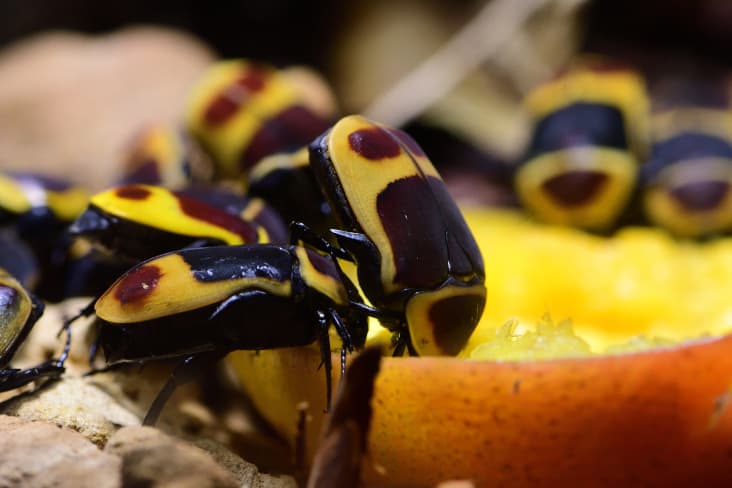
Feeding sun beetles
For the larvae, it is quite easy. They can feed on the decaying organic matter in the substrate. Essentially they don’t need any additional food sources but will eat from ripe fruits when they get the chance (and that is no problem whatsoever). But for the best development of grubs, you need enough decaying leaves and rotten wood where grubs can feed on.
After a while, you see the substrate covered with little round balls: that are larvae poop. When you see the floor slowly covering with poop pellets, it is time to refresh some substrate. It is an indicator that it is time for cleaning and time for adding new food for your grubs.
Sun beetles are also known as fruit beetles and are magnificent in detecting fruits from miles on scent alone. Adult beetles almost solely eat on ripe fruit alone. Any soft, sugary and moist fruits are suitable for adult beetles. Try to add some variety and not feed them one type of fruit every day. It could lead to nutritional deficiencies.
You can provide the fruit directly on the substrate so that grubs can eat it as well. However, keep an eye on it because grubs will slowly drag pieces of fruit down under the substrate. If it stays there for too long, it will rot and is quickly followed by rapid mould and bacteria growth. And besides that, it smells terrible.
Sun beetles love the commercially available beetle jelly. You can treat them with this food once in a while, although it is much more pricey than fruits.
Cleaning routine
If you refresh the food regularly and do some spot cleaning (remove mould spots or dead beetles), there is not much more cleaning to do. Easy, right? If you have a glass enclosure, you should clean the windows with water once in a while (don’t use soap or window cleaner, the chemicals are lethal to beetles). If you have many lime stains on your windows, rub the windows with some freshly cut lemons. It is a handy trick to get the windows perfectly clean.
Periodically you should refresh parts of the substrate. Don’t refresh the substrate in one go. Always leave some old substrate in the exhibit. But huh, why? Grubs adjust their intestinal tract on the current substrate and have difficulties when they are provided with another (fresh) substrate from one day to the next. Grubs rely on microbes in their hindgut (also known as hindgut fermentation) to break down highly fibrous materials. So, best to leave one-third of the old substrate on the bottom of the enclosure and fill it with the new substrate.
That’s it! As you can see, maintenance is rather easy for these beetles.
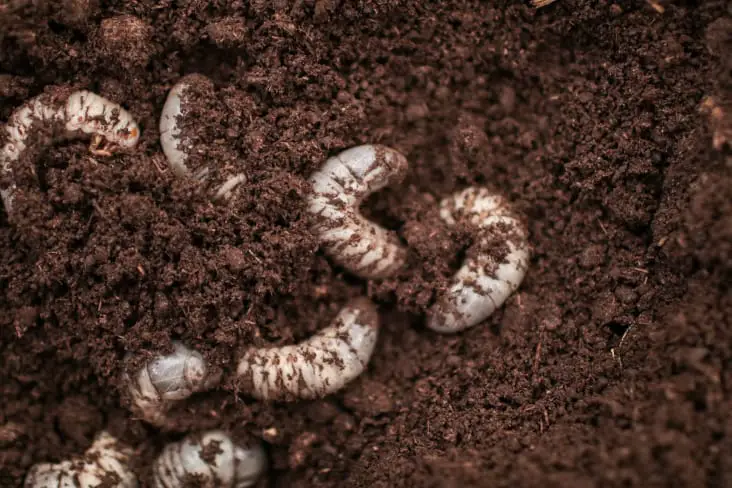
Breeding with sun beetles
It is quite easy to breed with sun beetles. It is not considered a pest animal by accident. If you place a couple of sun beetles together, you quickly find tiny white grubs in the substrate. You can rear grubs in a separate enclosure, but it is just as easy to rear them in the same enclosure as your adult beetles live.
There are a few ways to increase the success of breeding with sun beetles:
- Provide a good layer (~ 4″/10cm) of a substrate with enough decaying wood and leaves mixed in it.
- Keep the substrate moist — not soaking wet but also not let it dry out
- Create a stable temperature of around 68°F and 80°F (20°C-26°C). Please don’t use a heating pad below the enclosure; it will dry out the substrate.
- Make sure there is enough space for the number of grubs you have. Overcrowding will negatively impact your grubs from pupating in peace.
If you place rotten wood pieces in the substrate, you probably find a vast majority of cocoons on the underside of it. Grubs tend to choose to attach their cocoon to the wood pieces, as shown in the photo below.
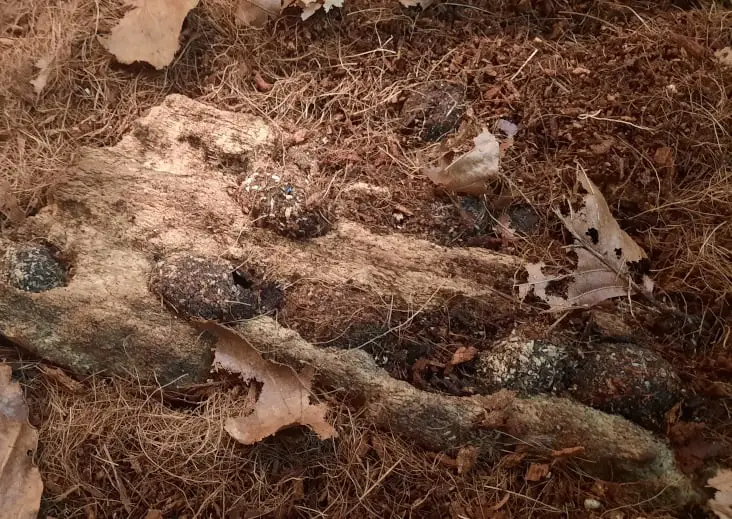
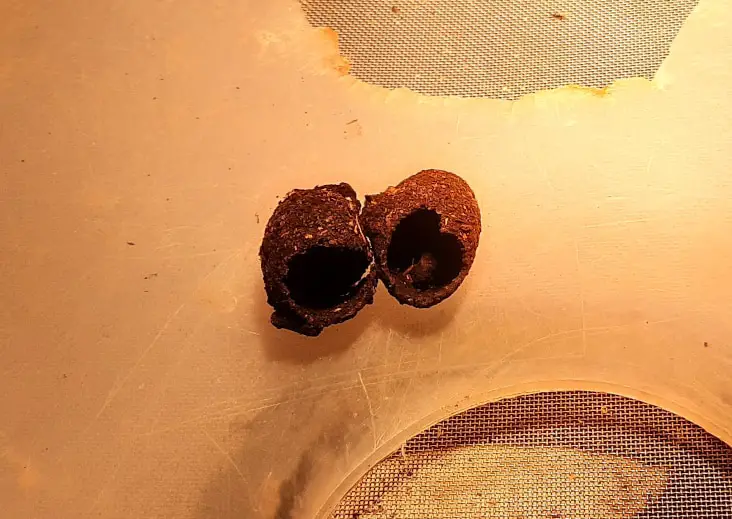
Communal setup with sun beetles
Do you want even to have a more interesting setup? You can house sun beetles with different other bugs as well. I’ve kept my sun beetles in setups with African giant black millipedes and African giant snails. Other roommates that seem to fit well are Madagascar hissing cockroaches and some species of stick insects like Indian Stick Insects and golden-eyed stick insects.
There are some things you need to think about before you try to house different species toegether:
- The species you want to house together should have relatively the same housing, environment, and climate requirements.
- You’ll need a bigger enclosure so that all the species have enough room and get out of each other’s way.
- You’ll need special attention to competition for food.
- Not all species have the same reproduction rate, which means that one species will have more individuals over time, driving other species away. Overcrowding can damage or stress all species.
When you consider these points, mixing different species is a fantastic challenge and makes it even more interesting to keep bug species.
Share this page!

